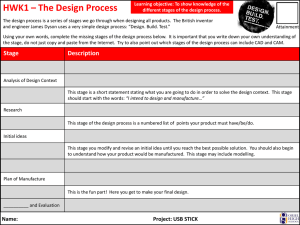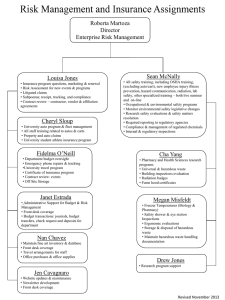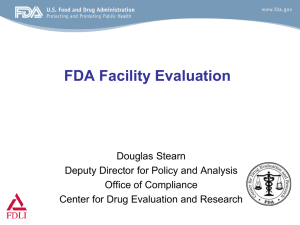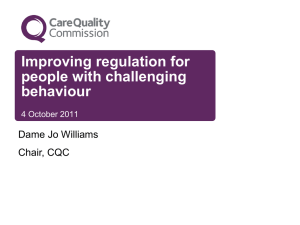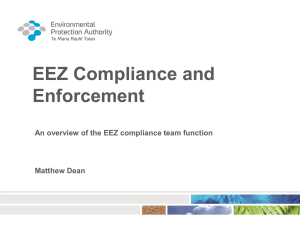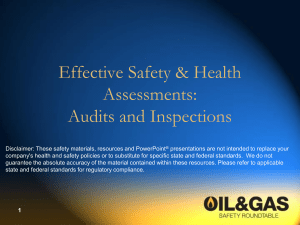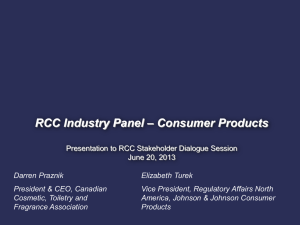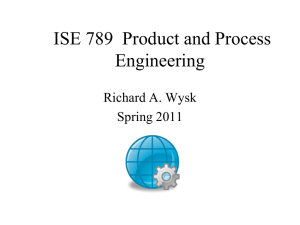Regulating the manufacture of therapeutic goods (Microsoft
advertisement
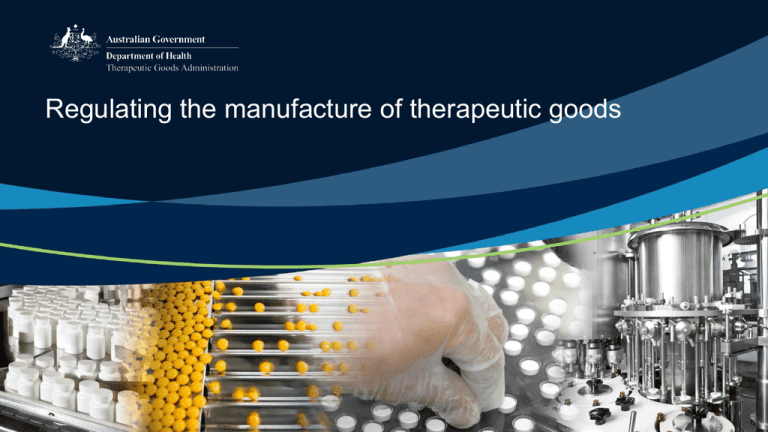
Regulating the manufacture of therapeutic goods Overview • Checking the quality of therapeutic goods • Higher, medium and lower risk products • The basis of Good Manufacturing Practice • Inspections − Australian manufacturers − international manufacturers • The future of manufacturing • Multi-step manufacturing processes • Looking at the actual product • International harmonisation • The manufacturer • Other education modules 2 Checking the quality of therapeutic goods The TGA monitors and assesses manufacturers to ensure that therapeutic goods supplied in Australia are manufactured to a high standard The emphasis and depth of manufacturer inspections, as well as the frequency of inspections, are guided by the inherent risks of the product and the method of manufacture. We also take into account the compliance and inspection history of the manufacturer 3 How do we do this Australian and overseas manufacturers are assessed prior to supply of goods and are then regularly reviewed On-site inspections of manufacturers and compliance verifications (paper-based assessments) Inspections against the relevant Code of Good Manufacturing Practice (GMP) or Standard (for devices) which describes the range of conditions required for the safe, sterile production of goods Quality manufacturing 4 Higher risk products • Sterile medicines, including active pharmaceutical ingredients • Single step sterilisers • Non-sterile medicines containing antibiotics, steroids or antineoplastics • Primary collection, processing and storage sites for blood, including human haematopoietic stem cells • Tissue banks with complex processing • Cellular therapies • Medical devices - Class III and Active Implantable Medical Devices (AIMD) Pacemakers are regulated as AIMDs 55 Medium risk products • Non-sterile medicines, including herbal products • Secondary blood collection and separation sites (including sites collecting plasma only or platelets) • Tissue banks with low manipulation • Other medical devices Plasmapheresis 6 Lower risk products • Minerals, vitamins, fish oils and other supplements • Sunscreens • Medicinal gases • Other blood collection sites including mobile units • Homeopathic medicines 7 The basis of Good Manufacturing Practice A basic tenet of GMP is that: • Simply testing a product after manufacture is not sufficient to ensure product quality • Quality must be built into each batch of a product during all stages of the manufacturing process 8 Looking at the actual product GMP requirements cover: • How products are manufactured, packaged, labelled and stored • How therapeutic goods are tested to ensure that products are of a suitable quality, including the final evaluation and approval for use by the manufacturer of each batch made 9 The manufacturer must: Have a quality management system in place under which manufacturing activities are controlled Include in the system personnel involved in the control of therapeutic goods manufacturing and how they are trained Provide information on how premises used in the manufacture of goods are designed, operated, maintained and controlled Control manufacturing activities through the use of written procedures and instructions Record manufacturing events through comprehensive record keeping practices 10 Inspections include verification that: All manufacturing processes are clearly defined and regularly reviewed Records of all manufacturing activities are kept Critical manufacturing processes and changes are validated All starting materials and finished products are sampled, tested and approved for use using appropriate methods Written instructions for all tasks are developed and available Batches are certified as fit-forpurpose prior to distribution 11 Inspections ensure quality of therapeutic goods • Planned and unplanned inspections are undertaken to assess compliance with GMP standards, both domestically and overseas • The emphasis, depth and frequency of inspections for a particular manufacturer are guided by the inherent risks of the product and the method of manufacture as well as: – manufacturer size – complexity of their products – compliance history 12 Inspecting Australian manufacturers In Australia, the TGA manages annually: • ~450 sites • ~250 inspections of sites Percentage (%) • ~400 licences for manufacturing, supply and distribution sites Compliance Ratings 90 80 70 60 50 40 30 20 10 0 good/average basic Level of Compliance unacceptable *statistics per annum, current as of July 2013 13 Manufacturers who receive a basic rating • Where ‘basic’ is considered just acceptable, the TGA applies a specific strategy to each manufacturer to enforce improvement by a combination of the following: – follow up and close out inspections where required – a letter to outline any concerns where required – inspections every 12 months 14 Which countries supply to Australia? Therapeutic goods are manufactured and supplied in a global market Sites: Europe India This includes both finished goods and ingredients Countries who manufacture or supply to Australia include: China US/Canada Other *current as of July 2013 15 Inspecting international manufacturers Compliance Ratings TGA inspection and certification of overseas sites 90 80 • ~3,500 clearances • 150-200 on-site inspections • Increasing number of compliance verifications (using inspection reports from other agencies) 70 Percentage (%) • ~2,000 manufacturers > 2,500 sites 60 50 40 30 20 10 0 good/average basic Level of Compliance unacceptable *statistics are per annum, current as of July 2013 16 The future of manufacturing Manufacturing is being expanded to developing countries Faster access to products for Australians Multi-step manufacture of products is common Complex supply chains which may span many different countries Challenges with different languages 17 Multi-step manufacturing process Example of an over-the-counter medicine The manufacturing process for medicines may occur in stages. In the following real world example, an over-the-counter medicine may be handled by four different companies across three countries before it reaches the market. Company B • Manufacture active ingredient Company A USA United Kingdom • Packaging and labelling • Quality control Company D • Secondary labelling Australia • Release for supply Company C Australia 18 Multi-step manufacturing process Example of a prescription medicine Company A – in Pennsylvania, USA – may complete every stage of the manufacturing process OR it may only manufacture the active ingredient, with the following stages being completed in one of a number of alternative sites Company A Virginia, USA • Manufacture of dosage form Company B the Netherlands • Secondary packaging • Release for supply Company B Australia • Secondary packaging • Release for supply Company C Australia • Release for supply 19 International harmonisation • International harmonisation of standards and inspections allows for a shared workload with regulators in other countries • It may include: – joint inspections with overseas partners – shared inspection scheduling – sharing of information, reports and manufacturer information – mutual recognition of codes of GMP and standards 20 Other education modules include: Introduction to the TGA Medicines Biologicals Medical devices Postmarket monitoring 21

